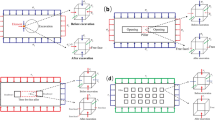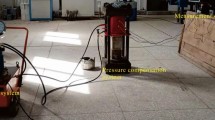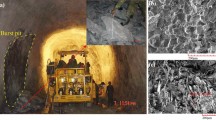Abstract
The aim of this study was to develop a systematic method to analyze the rock failure mechanism under stress unloading conditions. In this method, three types of basic tests (Brazilian splitting, direct shear, and three-point bending) were used to extract acoustic emission (AE), dissipative energy, and fracture parameters to analyze the failure mechanism under stress unloading. The key parameters are as follows: the critical slope in rise time/amplitude—average frequency (RA-AF) coordinate system; the dissipation energy (us and ut) of unit shear and tensile cracks; relative roughness (δ) of fracture—variation coefficient of gray value of digital image for fracture. Additionally, the effectiveness of this method was illustrated by a rock burst experiment. The results show that most (92.3%) of the fragments during rock burst were produced by tension, while the energy consumed by shear cracks is ~ 1.03 times of tensile cracks. Moreover, the density of AE events is negatively correlated with the amount of released energy. Furthermore, the tensile microcracks concentrated as a splitting zone after yielding but before burst. However, in the burst stage, the shear microcracks breakthrough to form a shear zone, while the elastic strain energy released was partially transformed into kinetic energy to form the ejection zone. In addition, for the dissipation energy, the energy consumptions by shear, tension, and plastic deformation account for 62.5%, 25.2%, and 12.3%, respectively.














Similar content being viewed by others
Abbreviations
- σt, P :
-
Tensile strength and peaking loading for Brazilian splitting test
- d1, h1 :
-
Diameter and thickness of disc specimen
- t1, h, a, S :
-
Thickness, height, length of pre-crack and span of bending specimen
- F max :
-
Failure loading in three-point bending
- K IC :
-
Fracture toughness
- RA:
-
Rise time divide by amplitude
- k :
-
Critical slope of shear and tensile micro-cracks
- E sd , E td :
-
Energy consumed by shear and tensile cracks
- u s , u t :
-
Energy consumed by unit shear and tensile cracks
- As, At :
-
Area of shear and tensile cracks
- Ee, Ed, Er :
-
Elastic, dissipation and residual strain energy for direct shear test
- δ :
-
Relative roughness
- SD gray matrix :
-
Standard deviation of gray matrix
- M gray matrix :
-
Mean value of gray matrix
- σ10, σ20, σ30 :
-
Initial maximum, intermediate, minimal principal stress, respectively
- σ X2 :
-
Stress in X2 direction
- U, Ue, Uk, Ud :
-
Total strain energy, elastic strain energy, kinetic energy, dissipation energy
- U r e :
-
Releasable elastic strain energy
- \( U^{p}_{d} \) :
-
Dissipation energy due to plastic deformation
- Ud1, Ud2 :
-
Dissipation energy during yielding and burst stages, respectively
- \( U^{s}_{d} ,U^{t}_{d} \) :
-
Dissipation energy by shear and tensile cracks
- d :
-
Particle diameter, maximum length of any two points of the fragment
- l, w, h :
-
Length, width and thickness of fragments
- a, b, c :
-
a and b are equatorial radii and c is polar radius of ellipsoidal
- n :
-
The number of sensors receiving a same signal
- E i :
-
Absolute energy measured by sensor i
- r i :
-
Distance between sensor i and the AE event
- Ẽ :
-
Equivalent released energy
References
Chen BR, Feng XT, Li Q et al (2013) Rock burst intensity classification based on the radiated energy with damage intensity at JinPing II hydropower station, china. Rock Mech Rock Eng 48(1):289–303
Chen S, Yin D, Jiang N, Wang F, Zhao Z (2019a) Mechanical properties of oil shale-coal composite samples. Int J Rock Mech Min Sci 123:104120
Chen ZY, Su GS, Ju JW et al (2019b) Experimental study on energy dissipation of fragments during rockburst. Bull Eng Geol Env. https://doi.org/10.1007/s10064-019-01463-9
Feng G, Kang Y, Wang XC et al (2020) Investigation on the failure characteristics and fracture classification of shale under brazilian test conditions. Rock Mech Rock Eng. https://doi.org/10.1007/s00603-020-02110-6
Frid V (1997) Rockburst hazard forecast by electromagnetic radiation excited by rock fracture. Rock Mech Rock Eng 30(4):229–236
Gong QM, Yin LJ, Wu SY et al (2012) Rock burst and slabbing failure and its influence on tbm excavation at headrace tunnels in JinPing II hydropower station. Eng Geol 124:98–108
He MC, Miao JL, Feng JL (2010) Rock burst process of limestone and its acoustic emission characteristics under true-triaxial unloading conditions. Int J Rock Mech Min Sci 47(2):286–298
He MC, Xia HM, Jia XN et al (2012a) Studies on classification, criteria and control of rockbursts. J Rock Mech Geotechn Eng 4(2):97–114
He MC, Nie W, Zhao ZY et al (2012b) Experimental investigation of bedding plane orientation on the rockburst behavior of sandstone. Rock Mech Rock Eng 45(3):311–326
He MC, Sousa LR, Miranda T et al (2015) Rockburst laboratory tests database—application of data mining techniques. Eng Geol 185:116–130
He MC, Ren FQ, Cheng C (2019) Experimental and numerical analyses on the effect of stiffness on bedded sandstone strain burst with varying dip angle. Bull Eng Geol Env 78(5):3593–3610
Hu XC, Su GS, Chen GY et al (2018) Experiment on rockburst process of borehole and its acoustic emission characteristics. Rock Mech Rock Eng 52:783–802
Huang RQ, Wang XN (1999) Analysis of dynamic disturbance on rock burst. Bull Eng Geol Env 57(3):281–284
Huang H, Babadagli T, Chen X, Li H, Zhang Y (2020) Performance comparison of novel chemical agents for mitigating water-blocking problem in tight gas sandstones. SPE Reservoir Eval Eng. https://doi.org/10.2118/199282-PA
Jiang Q, Feng XT, Xiang TB et al (2010) Rockburst characteristics and numerical simulation based on a new energy index: a case study of a tunnel at 2,500 m depth. Bull Eng Geol Env 69(3):381–388
Jiang N, Wang CX, Pan HY et al (2020) Modeling study on the influence of the strip filling mining sequence on mining-induced failure. Energy Sci Eng. https://doi.org/10.1002/ese3.660
Li TB, Ma CC, Zhu ML et al (2017) Geomechanical types and mechanical analyses of rockbursts. Eng Geol 222:72–83
Li A, Liu Y, Dai F et al (2020) Continuum analysis of the structurally controlled displacements for large-scale underground caverns in bedded rock masses. Tunn Undergr Space Technol 97:103288
Liu DK, Gu ZL, Liang RX et al (2020) Impacts of pore-throat system on fractal characterization of tight sandstones. Geofluids 2020(9):1–17
Mansurov V (2001) Prediction of rockbursts by analysis of induced seismicity data. Int J Rock Mech Min Sci 38(6):893–901
Miao JL, He MC, Li DJ et al (2009) Acoustic emission characteristics of granite under strain rockburst test and its micro-fracture mechanism. Chin J Rock Mechan Eng 28(8):1593–1603 (in chinese)
Miao SJ, Cai MF, Guo QF et al (2016) Rock burst prediction based on in situ stress and energy accumulation theory. Int J Rock Mech Min Sci 83:86–94
Nemat-Nasser S, Horii H (1982) Compression-induced nonplanar crack extension with application to splitting, exfoliation, and rockburst. J Geophys Res Solid Earth 87(B8):6805–6821
Ohno K, Ohtsu M (2010) Crack classification in concrete based on acoustic emission. Constr Build Mater 24(12):2339–2346
Ohtsu M (2008) Acoustic Emission Testing. Springer, Berlin Heidelberg
Ren D, Zhou D, Liu D, Dong F, Ma S, Huang H (2019a) Formation mechanism of the Upper Triassic Yanchang Formation tight sandstone reservoir in Ordos Basin—Take Chang 6 reservoir in Jiyuan oil field as an example. J Petrol Sci Eng 178:497–505
Ren FQ, Zhu C, He MC (2019b) Moment tensor analysis of acoustic emissions for cracking mechanisms during schist strain burst. Rock Mech Rock Eng 53(1):153–170
Shan PF, Lai XP (2020) An associated evaluation methodology of initial stress level of coal-rock masses in steeply inclined coal seams, Urumchi coal field, China. Eng Computation 37(6):2177–2192
Su GS, Chen ZY, Ju JW et al (2017a) Influence of temperature on the strainburst characteristics of granite under true triaxial loading conditions. Eng Geol 222:38–52
Su GS, Jiang JQ, Zhai SB et al (2017b) Influence of tunnel axis stress on strainburst: an experimental study. Rock Mech Rock Eng 50(6):1551–1567
Su GS, Zhai SB, Jiang JQ et al (2017c) Influence of radial stress gradient on strainbursts: an experimental study. Rock Mech Rock Eng 50(10):2659–2676
Sun Y, Tan CX (1995) An analysis of present-day regional tectonic stress field and crustal movement trend in china. J Geomech 1(3):1–12 (in chinese)
Troncone A, Conte E, Donato A (2014) Two and three-dimensional numerical analysis of the progressive failure that occurred in an excavation-induced landslide. Eng Geol 183:265–275
Wang J, Park H (2001) Comprehensive prediction of rockburst based on analysis of strain energy in rocks. Tunn Undergr Space Technol 16(1):49–57
Wang CX, Shen BT, Chen JT et al (2020) Compression characteristics of filling gangue and simulation of mining with gangue backfilling: an experimental investigation. Geomech Eng 20(6):485–495
Wong RHC, Law CM, Chau KT et al (2004) Crack propagation from 3-D surface fractures in pmma and marble specimens under uniaxial compression. Int J Rock Mech Min Sci 41(3):360–366
Wu G, Zhang L (2004) Studying unloading failure characteristics of a rock mass using the disturbed state concept. Int J Rock Mech Min Sci 41(s1):419–425
Zhang N, Liu W, Zhang Y, Shan P, Shi X (2020) Microscopic pore structure of surrounding rock for underground strategic petroleum reserve (SPR) caverns in bedded rock salt. Energies 13(7):1565
Acknowledgements
Financial support from the National Key Research and Development Program (Grant No. 2016YFC0801603) and Province Education Department of LiaoNing (Grant No. 2020LNQN04) are gratefully acknowledged. Additionally, thanks Dr. Xie Hao for his support of the three-point bending tests.
Author information
Authors and Affiliations
Corresponding author
Ethics declarations
Conflict of interest
The authors declared that there is no conflict of interest to this work.
Additional information
Publisher's Note
Springer Nature remains neutral with regard to jurisdictional claims in published maps and institutional affiliations.
Electronic supplementary material
Below is the link to the electronic supplementary material.
Rights and permissions
About this article
Cite this article
Ren, F., Chang, Y. & He, M. A systematic analysis method for rock failure mechanism under stress unloading conditions: a case of rock burst. Environ Earth Sci 79, 370 (2020). https://doi.org/10.1007/s12665-020-09111-2
Received:
Accepted:
Published:
DOI: https://doi.org/10.1007/s12665-020-09111-2




